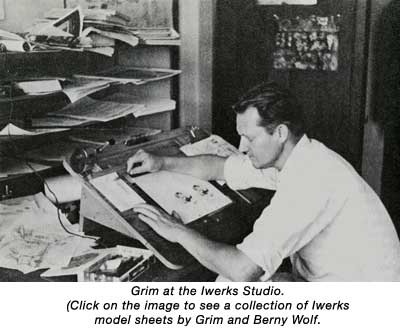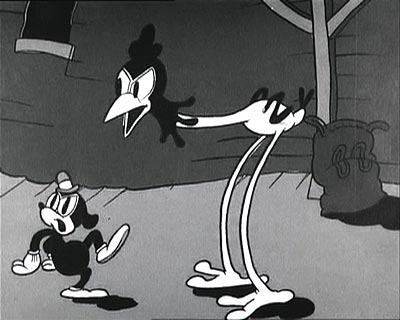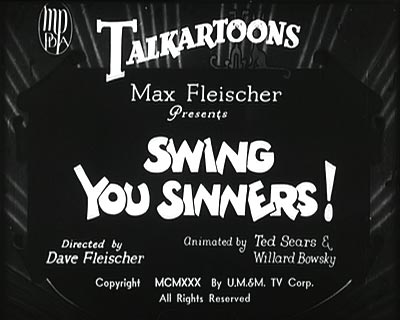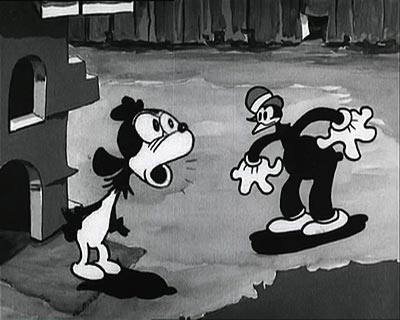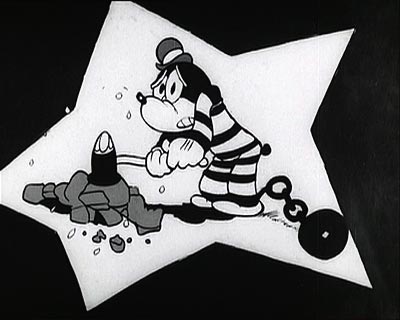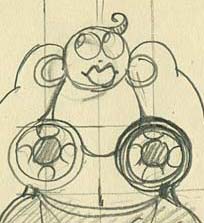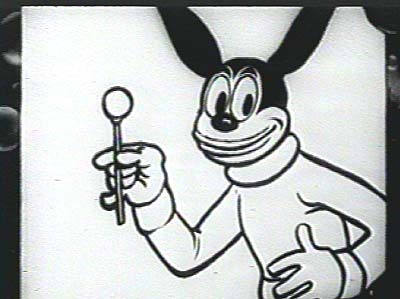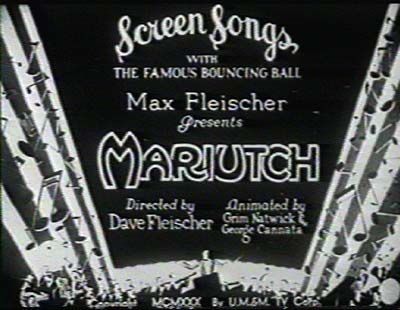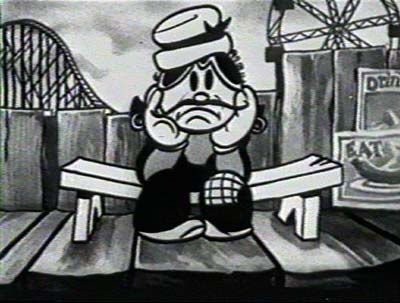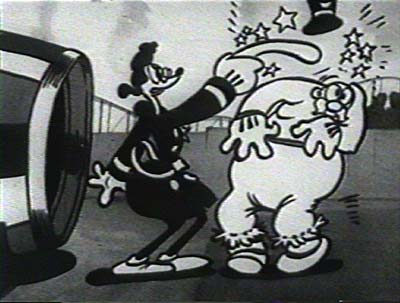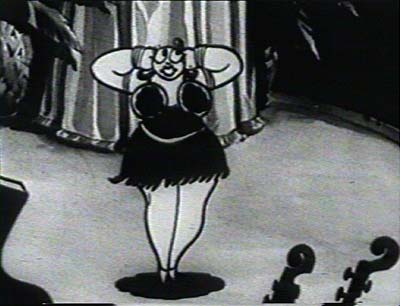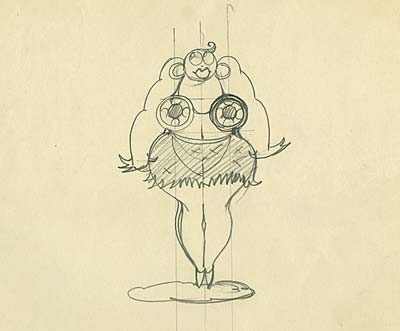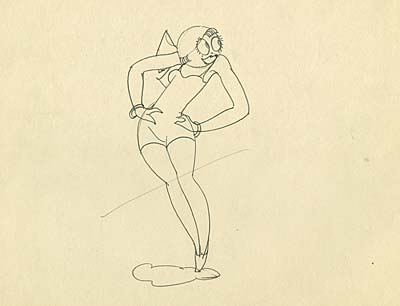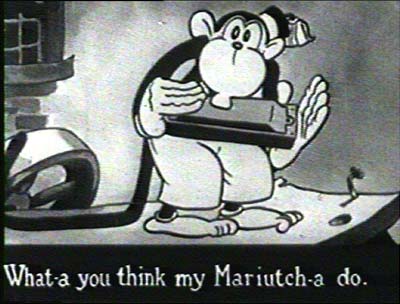PART TWO: GRIM NATWICK IN ANIMATION’S GOLDEN AGE
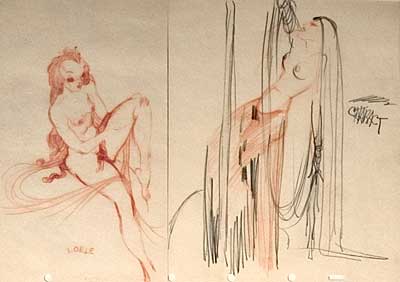
In California, Walt Disney had seen some of Grim Natwick’s animation of Betty Boop in "The Bum Bandit" and sent his brother Roy to New York to convince him to join them in Hollywood. Ub Iwerks had just left Disney to form his own studio, and an experienced animator was sorely needed to take his place. Roy Disney made Grim a remarkably generous offer, but Grim wasn’t sold on going to work for the Disney brothers. He spoke to his friends on the West coast and was advised that Walt Disney was just a businessman- Iwerks had been the real creative core of the studio. So Grim decided that Iwerks’ new studio was the place for him.
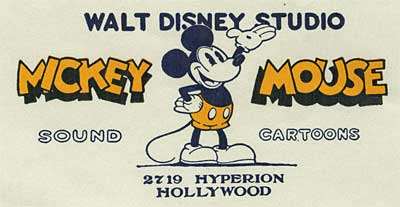
Click to read Disney’s offer to Grim.

![]() Several of Grim’s former assistants and co-workers from Hearst and Fleischer were already working for Iwerks. Grim phoned Ub and offered his services, agreeing to work for less than half what Roy Disney had offered him. When Grim arrived at Iwerks, he was so accustomed to leading the crew of young animators, he hit the ground running. Ub had lost interest in animation at this point, and willingly handed over the day to day direction of the cartoons to Grim, while he focused on tinkering in his workshop behind the studio.
Several of Grim’s former assistants and co-workers from Hearst and Fleischer were already working for Iwerks. Grim phoned Ub and offered his services, agreeing to work for less than half what Roy Disney had offered him. When Grim arrived at Iwerks, he was so accustomed to leading the crew of young animators, he hit the ground running. Ub had lost interest in animation at this point, and willingly handed over the day to day direction of the cartoons to Grim, while he focused on tinkering in his workshop behind the studio.
At Iwerks, Grim got the opportunity to direct, making a clear mark on films like "Jack Frost", "Room Runners", "Stratos Fear" and "Aladdin’s Lamp". But he always loved a challenge. When Grim heard that Disney was planning a feature length cartoon based on Snow White and the Seven Dwarfs, he knew he had to be a part of it. Ub offered him a full partnership in the studio to entice him to stay on, but money wasn’t Grim’s primary concern. Animation was. Grim reluctantly said goodbye to his friends at Iwerks and joined the Disney studios.
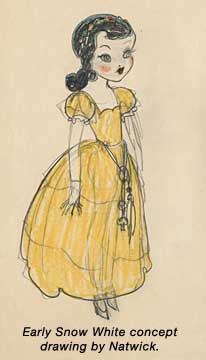
![]() Grim’s first animation for Disney was the female lead in "Cookie Carnival". He received great praise from Walt for his work, and was assigned the female lead in the upcoming feature, Snow White to animate. Grim was given some of the studio’s top assistants to work with- most importantly, Marc Davis, Les Novros and Jack Campbell. By the end of the picture, he had animated over 120 scenes, with six assistants working under him, producing as much as 35 feet of finished animation a week! (The average animator’s footage was about 7 feet a week.)
Grim’s first animation for Disney was the female lead in "Cookie Carnival". He received great praise from Walt for his work, and was assigned the female lead in the upcoming feature, Snow White to animate. Grim was given some of the studio’s top assistants to work with- most importantly, Marc Davis, Les Novros and Jack Campbell. By the end of the picture, he had animated over 120 scenes, with six assistants working under him, producing as much as 35 feet of finished animation a week! (The average animator’s footage was about 7 feet a week.)
Grim’s tenure at Disney was not without turmoil, however. Ham Luske had been promised the character of Snow White before Grim arrived at the studio, and he considered Grim’s assignment to be an incursion on his territory. Although Luske had the directing animator credit on the film, he had little direct interaction with Natwick’s unit. There was considerable tension on the lot between Walt’s boys- the animators who had been with Disney for years- and the East coast animators who had been hired for the feature. Grim paid no mind to it, focusing on his work, but the bad feelings would eventually boil over.
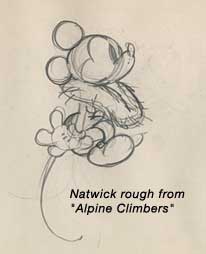
![]() Grim’s assistant, Jack Campbell showed promise and wanted to animate, so he was allowed to move to Luske’s unit as an animator. There are three Snow Whites in the finished picture… Luske’s, Campbell’s and Natwick’s. Luske’s girl is doll-like and close in style to the female leads in the Silly Symphony series (the scene with the bluebird in the forest is a good example), Campbell’s girl showed a strong influence of rotoscope (the scene at the wishing well). Natwick’s Snow White is the most lifelike and alive (the sequences where she investigates the Dwarf’s cottage, the house cleaning scenes, the dancing scenes and the "Someday My Prince Will Come" sequence). Grim was a better draftsman than either of the other artists and worked much faster. The lion’s share of the Snow White scenes were his, and he even animated a few scenes of the witch at the climax of the film.
Grim’s assistant, Jack Campbell showed promise and wanted to animate, so he was allowed to move to Luske’s unit as an animator. There are three Snow Whites in the finished picture… Luske’s, Campbell’s and Natwick’s. Luske’s girl is doll-like and close in style to the female leads in the Silly Symphony series (the scene with the bluebird in the forest is a good example), Campbell’s girl showed a strong influence of rotoscope (the scene at the wishing well). Natwick’s Snow White is the most lifelike and alive (the sequences where she investigates the Dwarf’s cottage, the house cleaning scenes, the dancing scenes and the "Someday My Prince Will Come" sequence). Grim was a better draftsman than either of the other artists and worked much faster. The lion’s share of the Snow White scenes were his, and he even animated a few scenes of the witch at the climax of the film.
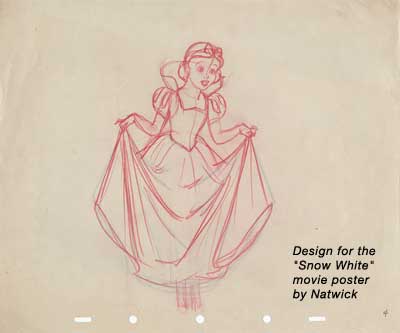
While Grim was putting in many hours of unpaid overtime, Dave Hand, the director, had promised a him bonus if the picture was a hit. But when the bonus checks went around, Grim was passed over, despite the fact that he was one of the key animators on the film. He contested the oversight with the paymaster and requested a copy of the draft to make a list of the scenes he had animated. He was disgusted to find that Luske’s name had been substituted for his own on scenes Grim himself had animated. When Max Fleischer called to invite Grim to join him at his new studio in Florida, Grim left Disney without a second thought. The paymaster had arranged for a token bonus, but Grim didn’t even bother to pick it up.
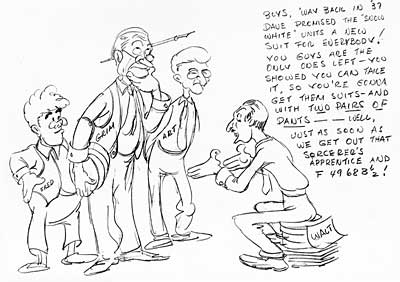
Looking back on the situation many decades later, Grim felt that perhaps he should have swallowed his pride and stayed on with Disney to work on Fantasia and Pinocchio. Gulliver’s Travels wasn’t Natwick’s best work. He didn’t have the support of talented assitants like Marc Davis, and the application of the rotoscope was much more limiting than it had been at Disney. But after the political struggles at Disney, the Fleischer Studio felt like home, and Grim enjoyed the company of his co-workers.
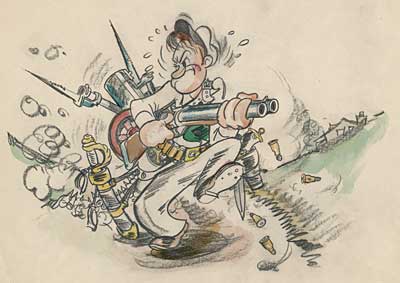
Grim Natwick Concept Drawing
For "Flies Ain’t Human" (1941)
One afternoon, Max Fleischer visited Grim in his office and asked him to animate a sequence of Betty Boop for "old time’s sake". He explained that Betty had been a great asset to the studio, but the series had run its course, and this was to be the final Betty Boop cartoon. (The cartoon in question was most likely "Musical Mountaineers".) Max expressed his appreciation and offered to make a gift of the character to Grim upon the completion of the film. Not knowing anything about the legalities of transferring ownership of a property, Grim did nothing about it. But years later, he read in the trades that the rights to Betty Boop had been sold by the Fleischers to King Features Syndicate for a great deal of money. Grim sued, but he had nothing in writing and lost the case. Although some writers have tried to belittle Grim’s contribution to the creation of Betty Boop, saying that his part was minimal, history bears out the fact that the character was 100% the creation of Grim Natwick.
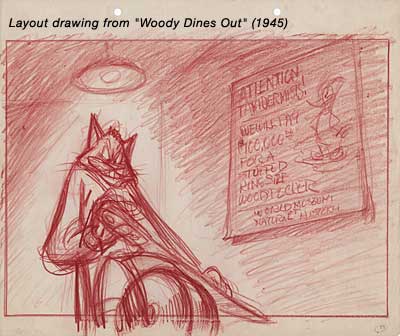
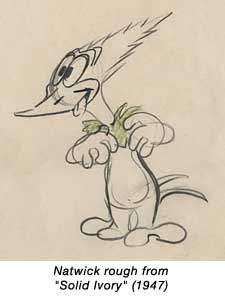
![]() World War II made it difficult to find work as an animator, but Grim’s old friend Walter Lantz was producing animated training films for the War Department. Grim returned to Hollywood to work for Lantz, where he had the opportunity to reunite with longtime friends like Shamus Culhane and Dick Lundy. In fact, Grim picked up his lunchtime game of horseshoes with storyman "Bugs" Hardaway right where they had left it when he left Iwerks ten years earlier! Lantz’s friendly, family atmosphere appealed to Grim, but he didn’t become complacent. He reinvented his style to suit the brash, slapstick style of animation at the time, and succeeded in creating some of the finest animation ever produced at Lantz.
World War II made it difficult to find work as an animator, but Grim’s old friend Walter Lantz was producing animated training films for the War Department. Grim returned to Hollywood to work for Lantz, where he had the opportunity to reunite with longtime friends like Shamus Culhane and Dick Lundy. In fact, Grim picked up his lunchtime game of horseshoes with storyman "Bugs" Hardaway right where they had left it when he left Iwerks ten years earlier! Lantz’s friendly, family atmosphere appealed to Grim, but he didn’t become complacent. He reinvented his style to suit the brash, slapstick style of animation at the time, and succeeded in creating some of the finest animation ever produced at Lantz.
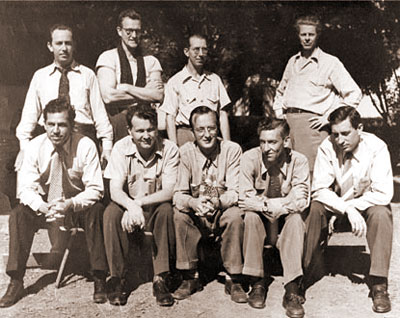
Lantz Animators in 1944 (Back Row: Paul Smith, Grim Natwick, Sidney Pillet, Bernard Garbutt Front Row:Les Kline, Shamus Culhane, Pat Matthews, Dick Lundy, Emery Hawkins)
Grim’s earliest work at the studio included "Take Heed Mr. Tojo" starring Hook, and "Enemy Bacteria", one of the most successful Wartime training films. His great animation for Dick Lundy and Shamus Culhane stood out in films like "Who’s Cookin’ Who", "Bathing Buddies", "Ski For Two" and "Solid Ivory". In his autobiography, Walter Lantz cited Natwick as the best animator he ever had the pleasure of working with.
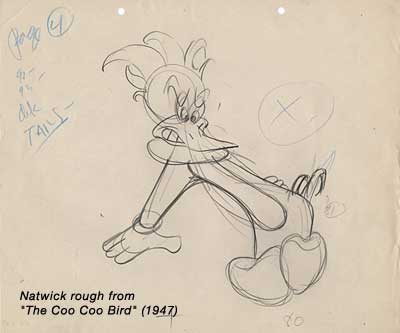
EXHIBIT CATALOG: GRIM NATWICK GOLDEN AGE ANIMATOR
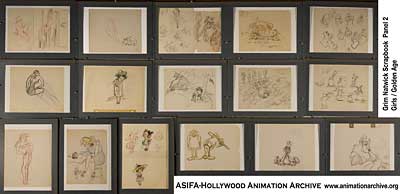
Top Row: (left to right) Girl doodles* (ca. 1936) / Snow White Animation Rough* / Left: Character designs from "Funny Face"* (1933) Right: Animation drawing from "Stormy Seas"* (1932) / Studio gag drawing from Iwerks / Tracings from Natwick Animation of Wally Walrus from "The Beach Nut" (1944)
Middle Row: (left to right) Girl doodle (ca. 1936) / Girl doodle (ca.1940) / Studio gag drawing depicting Ub Iwerks as a boy playing hookey from school* / Studio gag drawing for Art Turkisher* / Character designs from "Enemy Bacteria"*
Bottom Row: Character design for Miss X from "Abou Ben Boogie"* (1944) / Caricature of Lantz Ink & Paint girl / Character designs (ca. 1940) / Character design for "Sliphorn King of Polaroo" (1945) / Animation drawing from "Abou Ben Boogie"* (1944) / Animation drawing from "Who’s Cookin’ Who?"* (1946)
* denotes a drawing by Grim Natwick
Next Chapter: GRIM NATWICK IN THE MODERN AGE (UPA and beyond)
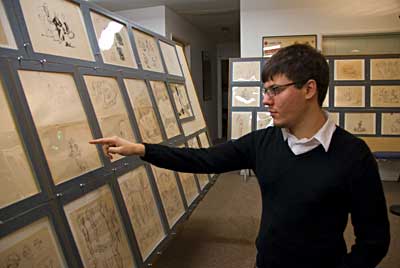
Assistant Archivist, Joseph Baptista views the exhibit.
GRIM NATWICK’S SCRAPBOOK
This travelling exhibit has appeared at the ASIFA-Hollywood Animation Archive in Burbank, CA and at the South Wood Historical Society Museum in Wisconsin Rapids, WI, birthplace of Grim Natwick.
Stephen Worth
Director
Animation Resources
This posting is part of an online exhibit entitled Grim Natwick’s Scrapbook.














